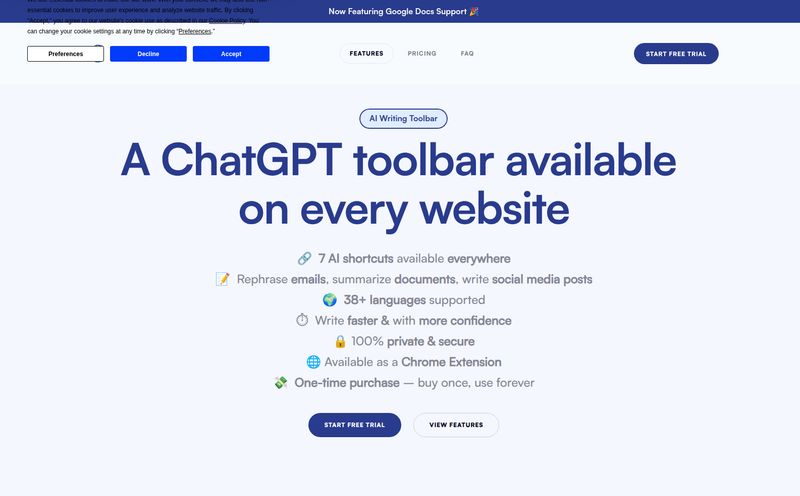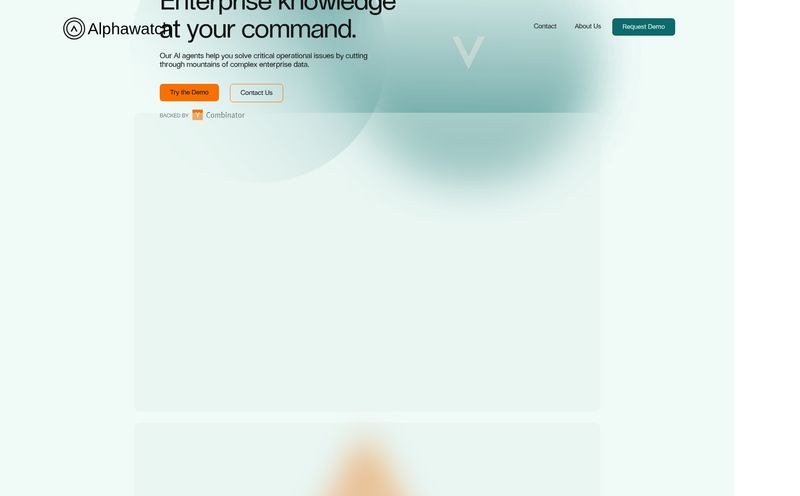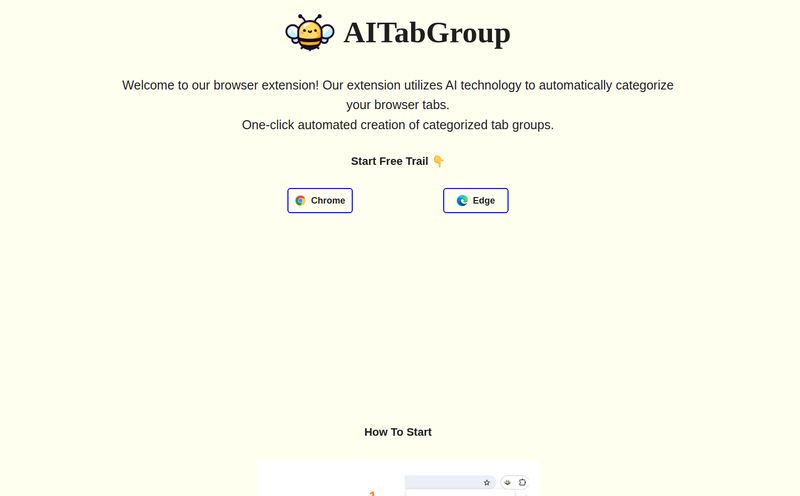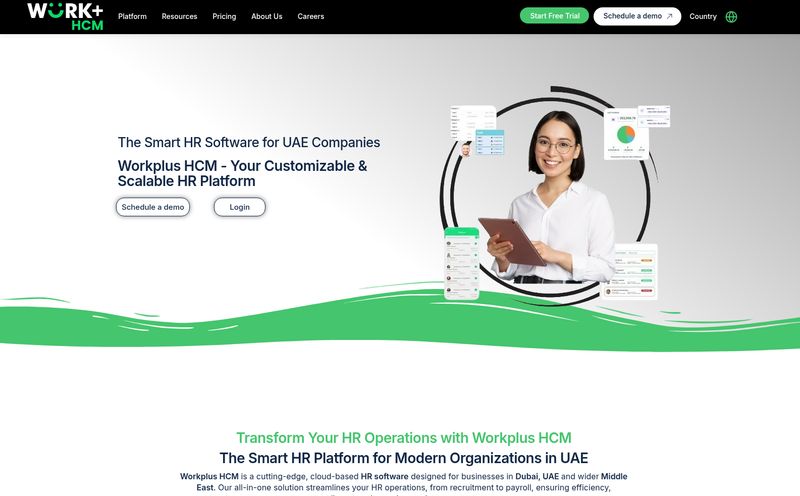How many of you have a to-do list app that you meticulously populate with tasks, only to stare at it with a sense of mounting dread? It’s a graveyard of good intentions. A static, judging monument to all the things you should be doing. I've tried them all. From the hyper-minimalist to the everything-but-the-kitchen-sink project management behemoths. And most of the time, they just end up making me feel worse.
The problem is that they're rigid. They lack... life. They don't adapt to my mood, my energy levels, or the sudden, brilliant (and probably distracting) idea that pops into my head at 2 PM.
So when I stumbled upon Flowlist.io, my inner productivity nerd sat up a little straighter. The tagline? An “AI-powered todo list app that dynamically refines and keeps tasks interesting.” It’s an experiment, they say. It has rough edges. And it’s free. Okay, you have my attention. I'm a sucker for an underdog project, especially one that promises to shake up one of the most static corners of the digital world.
So, What on Earth is Flowlist?
Before we go any further, just look at the quote that greets you on their site: “Whenever I’m about to do something, I think, ‘Would an idiot do that?’ and if they would, I do not do that thing.” — Dwight Schrute. Instantly, I knew this wasn't going to be your typical, sterile productivity tool. It has a personality. A slightly weird, but appreciated, personality.
At its core, Flowlist is a web app that uses AI to help you break down your goals. You don’t just write “Launch new blog.” Instead, you throw that vague, intimidating idea into the input box, and the AI suggests a project name and a list of actionable first steps. It’s designed to be a conversation starter with yourself, turning a daunting task into a series of smaller, more approachable actions.
It calls itself an “experiment in using AI to dynamically refine and discern what’s on your mind.” I love that phrasing. It’s not promising to solve all your problems. It’s inviting you to play.
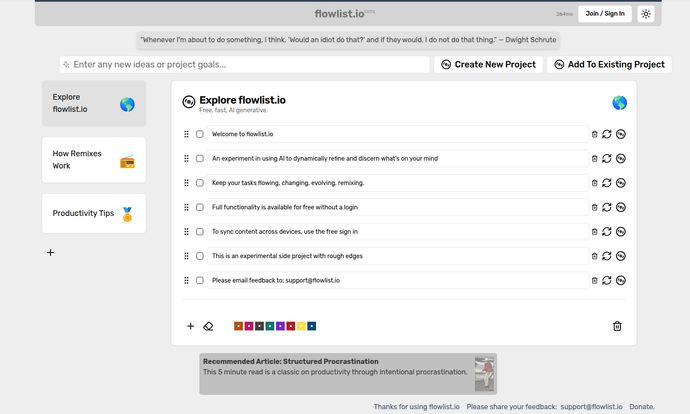
Visit Flowlist
My First Spin with Flowlist
Getting started is, and I can't stress this enough, ridiculously easy. There's no sign-up wall. No credit card required. No “start your 14-day trial” nonsense. You just land on the page and… go. This is such a breath of fresh air. In a world where every service wants your email address just to show you what it does, Flowlist just opens the door and lets you wander around.
I typed in my first goal: “Revamp my SEO strategy for Q3.”
Instantly, Flowlist generated a project titled “Q3 SEO Strategy Overhaul” and populated it with a few starter tasks:
- Conduct a full audit of current keyword rankings.
- Analyze top 3 competitors' backlink profiles.
- Identify low-hanging fruit for content updates.
- Schedule a brainstorming session for new pillar content ideas.
It’s not groundbreaking, but it’s something. It's a starting pistol. It got the ball rolling, which, as any procrastinator knows, is often the hardest part.
The Secret Sauce: AI Remixes and Dynamic Flow
Here’s where Flowlist starts to feel different. Next to each task is a little “remix” button (it looks like a refresh icon with a brain). Clicking it doesn't just rephrase the task; it often reframes it, sometimes offering a completely new angle. For instance, I remixed “Analyze top 3 competitors' backlink profiles,” and it suggested, “Find one surprising backlink source from a competitor and explore it.”
See the difference? The first is a chore. The second is a treasure hunt. It injects a dose of curiosity into the process. It’s like having a brainstorming partner who’s constantly saying, “Okay, but what if we looked at it this way?” This dynamic nature is the whole point. Your to-do list is no longer a stone tablet; it’s a living document, a stream of consciousness that you can guide and shape.
The Good, The Bad, and The Quirky
No tool is perfect, especially one that proudly calls itself an experiment. After spending a good few days using it for my personal brain dumps and side-project planning, here's my honest breakdown.
What I Genuinely Liked
First off, the price. It's free. Not “freemium,” where all the good stuff is locked away. All the core functionality is available without even creating an account. If you do create a free account, you get the added benefit of syncing your lists across devices, which is a pretty standard but necessary feature.
The simplicity is another huge win. I didn’t need a tutorial. There aren’t a million buttons and menus to get lost in. It’s a text box, a couple of buttons, and your list. This minimalist approach is a direct antidote to the feature bloat that plagues so many other apps.
And I have to admit, the AI-driven motivation actually works. It's surprisingly good at turning my vague anxieties (“I need to get more clients”) into concrete, less-scary first steps (“Draft a cold email template for local businesses”). It’s a small psychological shift, but it matters.
Where Things Get a Bit Bumpy
Okay, let's talk about the “rough edges.” It’s not a lie. Sometimes the AI suggestions are a bit… weird. Or repetitive. It's clear that this is a side project, not a product with a hundred developers behind it. It can feel a little fragile at times, though I personally haven't experienced any major bugs.
The biggest thing to understand is its scope. This is not a replacement for Asana, Trello, or Jira. If you need to manage a complex project with multiple stakeholders, dependencies, and detailed timelines, this is not the tool for you. Trying to use it for that would be like trying to tow a boat with a bicycle. It’s just not built for heavy lifting.
It also requires your participation. The quality of the output depends entirely on the quality of your input. You have to give it your key concerns and goals for it to have anything to work with. It's a partner, not a magician.
So Who Is This Actually For?
After playing around, I have a pretty clear picture of the ideal Flowlist user.
This tool is for:
- The Chronic Procrastinator: Someone who gets paralyzed by the sheer size of a task.
- The Creative Professional: Writers, designers, and marketers who need to brainstorm and break down abstract ideas.
- Students: Perfect for breaking down study topics or large essay assignments.
- Anyone with a touch of ADHD: The novelty of the “remix” feature can provide just enough dopamine to keep things engaging.
- Productivity App Minimalists: People who are tired of overly complicated systems.
It’s for the individual. The solo-preneur. The person whose main battle is with their own inertia, not with coordinating a team of ten.
A Fun Nod to Productivity Nerds
One little detail I loved was a recommendation at the bottom of the page for an article on “Structured Procrastination.” This is a concept by Stanford philosopher John Perry, who argues you can trick yourself into being productive by using less important tasks to avoid more important ones. The fact that the creator of Flowlist included this shows they get their audience. They understand the weird mental gymnastics we go through to get things done. It’s a fantastic little easter egg for those in the know.
My Final Verdict on Flowlist
So, is Flowlist a game-changer that will revolutionize the productivity space? Probably not. And I don’t think it’s trying to be. What it is, is a clever, fun, and genuinely useful tool for a specific kind of problem: getting started.
It’s a digital muse. A brainstorming buddy. It’s the friend who helps you untangle the spaghetti mess of thoughts in your head so you can find a single noodle to start with. And because it's completely free and requires zero commitment to try, there’s literally no reason not to give it a shot.
It won't organize your entire life for you, and it won't manage your team's next big launch. But it might just be the thing that helps you finally start writing that book, planning that trip, or, in my case, tackling that Q3 SEO strategy with a little more curiosity and a lot less dread.
Frequently Asked Questions
- Is Flowlist really free to use?
- Yes, it's completely free. The core features are all available without paying a dime or even signing up. The developer seems to be running it as a passion project.
- Do I need to create an account for Flowlist?
- No, you can start using it immediately without an account. However, creating a free account allows you to save your lists and sync them across different devices.
- Can I use Flowlist for complex team projects?
- It's not recommended. Flowlist is designed for individual use, brainstorming, and managing personal tasks. It lacks the collaboration features, integrations, and complexity needed for team-based project management.
- How does the AI in Flowlist actually work?
- It takes the initial goal or idea you provide and uses a generative AI model to break it down into smaller, actionable steps. It's trained to suggest motivating and logical next actions to help you overcome inertia.
- What is the "remix" feature?
- The remix feature allows you to take an existing task on your list and have the AI generate a new version of it. It’s a way to find a new perspective on a task, rephrase it to be more motivating, or break it down even further.
- Can I use Flowlist on my phone?
- Yes, it's a web app, so it works in any modern browser on your desktop or mobile phone. If you create a free account, your lists will sync between them.
Reference and Sources
- Flowlist Official Website: https://flowlist.io/
- John Perry on Structured Procrastination: http://www.structuredprocrastination.com/
